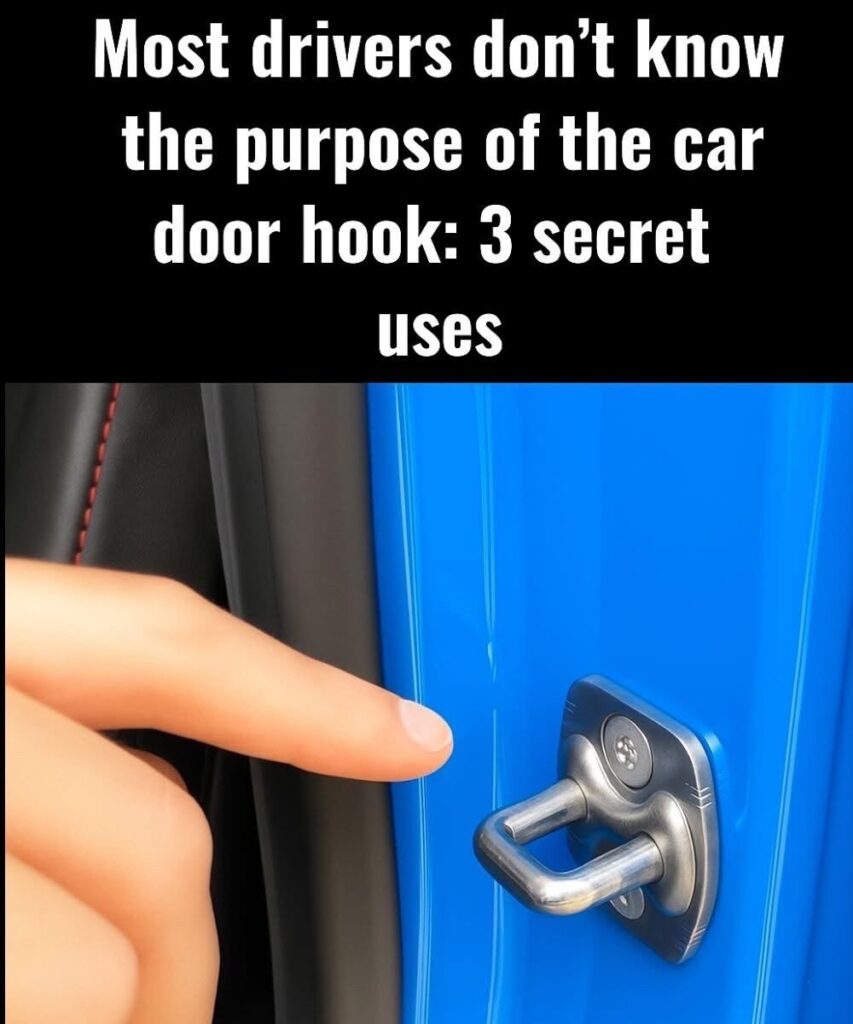When I bought my first car, I didn’t know much about how it worked. I could drive it, sure. I knew how to pump gas, clean the windshield, and awkwardly ask the mechanic what “that rattling sound” was. But the small things? The odd hooks, clips, and parts you see but never think twice about? Those flew completely under the radar.
One of those things? That metal hook on the car door frame.
You know the one. It looks like a thick metal U-shape, bolted into the door jamb of your car. It’s solid, almost industrial looking. Most drivers glance at it a hundred times without giving it a second thought.
But here’s the thing: that hook isn’t just there for decoration—or even just for keeping the door closed.
It actually serves multiple hidden purposes, and understanding them can make your driving experience safer, more convenient, and even save you money down the line.
So buckle up. This isn’t just a random car part. It’s a quiet little feature with some surprisingly clever functions.
🚗 What Is the Car Door Hook, Technically?
Before we dive into the hidden uses, let’s clear something up: the proper name for this piece is the “striker plate” or “door striker.”
It works in tandem with your car door latch to keep the door securely shut. When you close the door, the latch grabs onto the striker and holds tight—kind of like a handshake between the door and the frame.
But here’s where things get interesting: automakers have designed this little hook to do more than just lock your door.
Let’s explore the three unexpected ways this humble hook comes in handy.
🛡️ 1. It Plays a Big Role in Crash Safety (Yes, Seriously)
Most people assume airbags and seatbelts are doing all the work during a collision. And while they’re definitely the A-listers of car safety, that little hook plays a critical supporting role.
Here’s how:
During a crash, especially a side-impact collision, the striker plate helps keep the door shut under intense force. That’s crucial. If the door were to pop open during a crash, passengers could be ejected—or hit with flying debris.
The striker plate is designed to hold the door in place, resist bending, and keep the cabin sealed. It creates a rigid connection between the door and the car’s body, effectively forming a protective shell.
In short: that hook is part of your car’s safety cage.
And it’s not just theory. In crash tests, cars with stronger striker systems consistently fare better in keeping passengers protected.
So the next time you close your car door and hear that satisfying “clunk”? Know that it’s not just a door closing. It’s a safety system engaging.
🧳 2. It’s a Mounting Point for Car Accessories
Here’s something most drivers (including me, until recently) never realize:
That hook can be used as a mount for some really clever car accessories.
From pet safety systems to organization tools, here are a few examples of how the striker plate can become your best friend:
➤ Car Door Step:
This small, foldable step hooks onto the striker and allows you to easily reach the roof of your vehicle. Perfect if you drive an SUV or roof-box-equipped sedan and are tired of climbing your tire like a monkey just to tie down a kayak.
➤ Pet Barrier Systems:
Some pet barriers that separate the back seat from the trunk area use the striker hook to anchor the system securely—keeping your furry friend safe and your driving distraction-free.
➤ Emergency Escape Tools:
Certain survival tools—like seatbelt cutters or glass breakers—can be mounted near the striker for quick access in case you’re trapped inside. Some systems even use it as a tether point for emergency rope ladders (useful in car fires or floods).
The beauty of the striker hook is that it’s strong, fixed, and universal—meaning accessory makers can count on it to hold weight and resist pressure.
You don’t need to be a mechanic to make use of it. Just a little awareness goes a long way.
🔇 3. It Can Be the Cause of Those Mysterious Car Noises
Ever heard an annoying rattling or squeaking noise coming from your door while driving over bumps or rough roads?
Here’s a secret: it might not be the door panel. It might be the striker plate misaligned.
Over time, if the door or the striker shifts even slightly (due to age, wear, or a minor bump), the latch may not grab it cleanly. This leads to micro-movements every time the car shakes—causing that infuriating sound you can never seem to locate.
The good news? It’s usually a quick fix. Mechanics can realign the striker plate or replace the plastic bushing that cushions it. In many cars, this piece is adjustable—so don’t suffer in silence thinking your whole door is falling apart.
Pro tip: If your door feels a bit loose when closed or you hear rattling in that area, ask your mechanic to inspect the striker hook alignment.
🛠️ Bonus Tip: Keep It Clean and Lubricated
Like any hard-working part of your car, the striker needs a little TLC.
Dirt, grime, and moisture can cause premature wear or make the door harder to close. A simple wipe-down with a clean rag and the occasional dab of silicone spray can extend its life and keep your door working smoothly.
Trust me—it’s 30 seconds well spent.
🔍 Final Thoughts: The Small Parts Matter More Than You Think
The striker hook on your car door is one of those “hidden in plain sight” features that we use every day without realizing just how smart—and essential—it really is.
It’s not just a door latch.
It’s a safety mechanism.
A mounting system.
A diagnostic clue.
And now, you’re one of the few drivers who actually knows what it does—and how to make the most of it.
So next time you get in your car, glance at that little hook. It’s quietly doing a lot more for you than you ever imagined.


